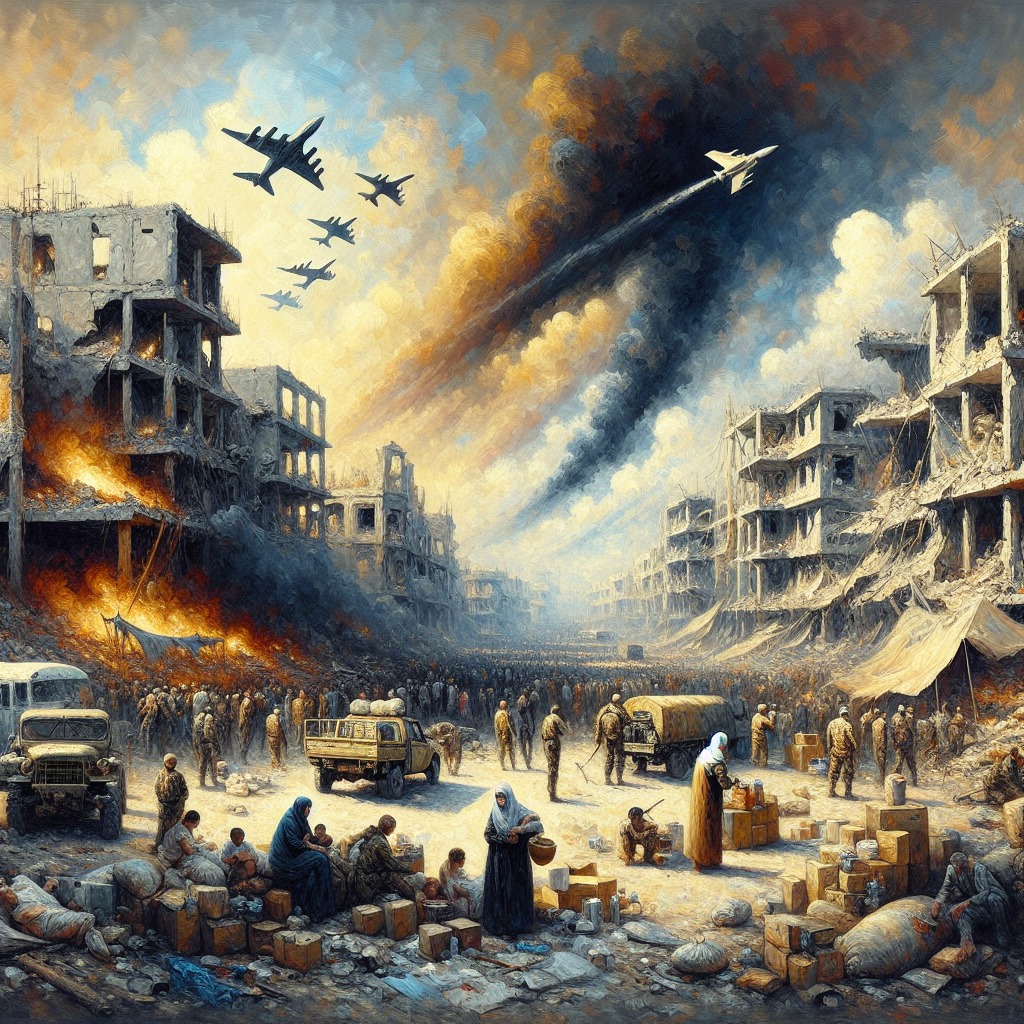The Middle East has become the epicenter of global attention as the Gaza conflict enters its 21st month, marking more than 600 days of continuous warfare that has reshaped the regional landscape and threatened international stability. What began as a surprise attack by Hamas on October 7, 2023, has evolved into a complex web of interconnected crises spanning multiple countries and involving numerous state and non-state actors.
Gaza War: Unprecedented Scale of Destruction and Casualties
The current phase of the Israel-Palestine conflict represents an unprecedented escalation in both scope and intensity. Israeli Defense Forces now reportedly control approximately 75% of Gaza territory, while the humanitarian situation has deteriorated to catastrophic levels. Recent independent surveys suggest the death toll may be significantly higher than official counts, with estimates ranging from 77,000 to 109,000 Gazans killed , representing 4-5% of the territory’s pre-war population .
The latest casualty figures from June 2025 paint a grim picture: over 58,400 people have been reported killed , including 56,772 Palestinians and 1,706 Israelis . Among the victims are 180 journalists and media workers, 120 academics, and over 224 humanitarian aid workers , with 179 employees of UNRWA included in this count. These numbers underscore the systematic targeting of civil society and the collapse of basic infrastructure throughout the territory.
Humanitarian Crisis Reaches Critical Point
The humanitarian emergency in Gaza has reached unprecedented levels , with civilians facing what experts describe as catastrophic conditions . The situation has been exacerbated by the dangerous circumstances surrounding aid distribution, where Palestinian civilians seeking food assistance have repeatedly come under fire.
Since late May 2025, more than 580 Palestinians have been killed and over 4,000 injured near aid distribution sites operated by the Gaza Humanitarian Foundation (GHF), a US and Israeli-backed organization. These deadly incidents have occurred as desperate civilians attempt to access basic necessities, highlighting the impossible choices faced by Gaza’s population between risking death from bombardment or starvation.
The controversial aid distribution system has been rejected by major international humanitarian organizations, including UN agencies, which argue it violates humanitarian principles by allowing Israel to control aid recipients and forcing dangerous relocations to distribution sites. Multiple witnesses have reported Israeli forces opening fire on crowds near these centers, with eyewitness accounts describing scenes of chaos and terror as families attempt to secure food for survival.
Diplomatic Breakthrough Attempts and Ceasefire Prospects
In a significant diplomatic development, former US President Donald Trump has expressed optimism about achieving a ceasefire, stating that an agreement could be reached ” within the next week “. This unexpected assertion has generated considerable attention, particularly as Trump indicated he had engaged with individuals involved in truce efforts, though he did not disclose their identities.
The urgency surrounding ceasefire negotiations has intensified following recent US and Israeli airstrikes on Iranian nuclear sites. Arab mediators, including Egypt and Qatar , supported by the United States, have launched new initiatives aimed at ending the 20-month conflict and facilitating the release of Israeli and foreign hostages held by Hamas.
Hamas has indicated its readiness to resume ceasefire discussions but maintains that any agreement must conclude the war and ensure complete Israeli withdrawal from Gaza. The organization has expressed willingness to release the remaining hostages— 20 of whom are believed to still be alive —only as part of a comprehensive deal that ends the conflict . In contrast, Israel insists the war can only conclude if Hamas is completely disarmed and dismantled , provided Hamas categorically rejects.
Regional Escalation: Syria Becomes New Battleground
The conflict’s regional dimensions have expanded significantly, with Israel conducting airstrikes in southern Syria targeting Hamas operatives and weapons depots. Since the fall of Syrian President Bashar al-Assad in December 2024, Israel has carried out hundreds of strikes on Syrian territory , targeting military sites and weapons storage facilities.
Recent Israeli operations have specifically targeted Hamas infrastructure in Syria , with the Israeli Defense Forces stating that “Palestinian terrorist organizations, led by Hamas, are using Syrian territory to establish terror operations under Iranian guidance” . These cross-border strikes represent a dangerous escalation that threatens to draw additional regional actors into the conflict.
The emergence of new militant groups in Syria, including the “Martyr Mohammed Deif Brigades” and the “Islamic Resistance Front in Syria,” has added another layer of complexity to the regional security situation. These groups have claimed responsibility for rocket attacks against Israeli territory, marking the first such incidents from Syria since Assad’s fall.
Iran’s Nuclear Ambitions and Proxy Network
Central to the escalating regional tensions is Iran’s continued resistance to international pressure on its nuclear program. Israeli Prime Minister Benjamin Netanyahu has been pushing for military action against Iranian nuclear facilities while Tehran is perceived to be in a weakened position. US officials have expressed growing concern about Iran’s nuclear program, with Trump stating unequivocally that ” they can’t have a nuclear weapon ” .
Iran’s sophisticated proxy network continues to threaten regional stability through multiple fronts. The country has been accused of providing advanced weapons systems, including missiles and drones , to various armed groups throughout the region . In Yemen, Iran has significantly enhanced the capabilities of the Houthis, enabling them to disrupt maritime security in the Red Sea and threaten global commerce .
The Iranian Revolutionary Guard Corps has stationed personnel in Yemen to directly assist Houthi operations , including targeting US military drones and commercial shipping. This support has allowed the Houthis to emerge as a dominant regional power and establish themselves as key players in Iran’s ” Axis of Resistance “.
Maritime Security Under Threat
The conflict’s impact on global maritime security has become increasingly pronounced, with Houthi attacks in the Red Sea disrupting one of the world’s most crucial shipping routes. These attacks, conducted with Iranian-supplied weapons and intelligence , have forced international shipping companies to alter routes and raised concerns about global supply chain security.
The precision and frequency of these maritime attacks demonstrate the sophisticated level of Iranian support provided to the Houthis, including advanced targeting systems and real-time intelligence sharing. This collaboration has effectively weaponized one of the world’s most important commercial waterways, with far-reaching implications for international trade and energy security.
Legal and International Dimensions
Iran has reportedly formed a dedicated legal team to address international pressure and potential sanctions related to its regional activities. This development suggests Tehran is preparing for prolonged international legal challenges while continuing to support proxy groups throughout the region.
The formation of this legal apparatus indicates Iran’s recognition that its regional activities may face increased scrutiny from international courts and legal bodies. This strategic legal preparation demonstrates Tehran’s commitment to maintaining its proxy network despite growing international pressure and potential consequences.
Humanitarian Organizations Under Pressure
The conflict has placed enormous strain on humanitarian organizations operating in the region. The controversial Gaza Humanitarian Foundation system has created a significant rift between traditional humanitarian principles and politically-aligned aid distribution mechanisms. Major international aid organizations have refused to participate in the new system, arguing it compromises neutrality and increases risks to civilian populations.
The targeting of humanitarian workers has reached alarming levels , with over 224 aid workers killed since the conflict began. This systematic targeting has severely hampered relief efforts and created additional barriers to addressing the humanitarian crisis affecting nearly the entire population of Gaza.
Looking Ahead: Uncertain Prospects
As the conflict enters its 21st month, the prospects for resolution remain highly uncertain . While diplomatic efforts continue, the fundamental disagreements between the parties appear as entrenched as ever. The expanding regional dimensions of the conflict, involving Syria, Iran, and maritime security in the Red Sea, suggest that any lasting solution will require addressing multiple interconnected issues simultaneously.
The international community faces the challenge of addressing not only the immediate humanitarian crisis in Gaza but also the broader regional implications of Iranian proxy activities and nuclear ambitions. The success of current diplomatic initiatives may determine whether this conflict remains contained or escalates into a broader regional confrontation with global implications.
The coming weeks will be crucial in determining whether the optimism expressed by US officials regarding ceasefire prospects can translate into concrete progress toward ending one of the most devastating conflicts in recent Middle Eastern history. The human cost continues to mount daily, making urgent resolution not just a political imperative but a moral obligation for all parties involved.
Ready to start your cryptocurrency journey?
If you’re interested in exploring the world of crypto trading, here are some trusted platforms where you can create an account:
- Binance – The world’s largest cryptocurrency exchange by volume.
- Bybit – A top choice for derivatives trading with an intuitive interface.
- OKX – A comprehensive platform featuring spot, futures, DeFi, and a powerful Web3 wallet.
- KuCoin – Known for its vast selection of altcoins and user-friendly mobile app.
These platforms offer innovative features and a secure environment for trading and learning about cryptocurrencies. Join today and start exploring the opportunities in this exciting space!

Join our crypto community for news, discussions, and market updates: CryptoBCC on Telegram.

Disclaimer: Always do your own research (DYOR) and ensure you understand the risks before making any financial decisions.




